For natural perfumes, you'll want to use vetiver at 20% of your total blend as a base note. Follow the 30-50-20 rule: 30% top notes (like citrus), 50% middle notes (such as florals), and 20% base notes including vetiver. You can adjust this slightly based on the season, with higher concentrations (up to 30%) working well in winter blends. The true magic of vetiver reveals itself through proper maturation and expert note selection.
Understanding Vetiver's Aromatic Profile
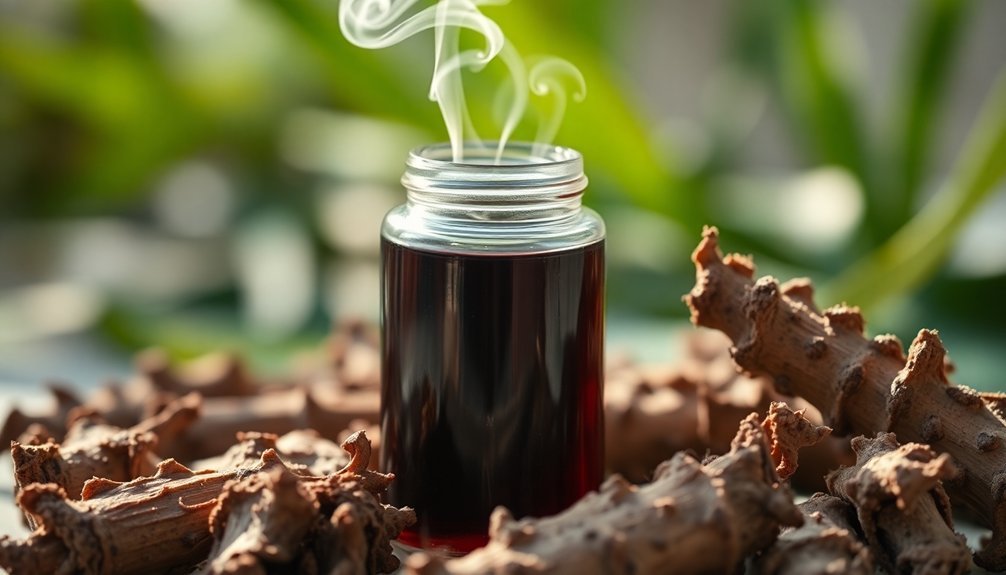
While many natural perfume ingredients offer straightforward scent profiles, vetiver stands out for its remarkably complex aromatic character.
You'll discover a rich foundation of woody and earthy notes reminiscent of damp soil, complemented by unexpected floral and fruity undertones that pair beautifully with citrus elements like grapefruit.
The scent's complexity deepens with its leathery and smoky undertones, while some varieties display invigorating lemony and green top notes similar to freshly cut grass. The oil's distinctive character comes from its sweet-woody vetiverol content, which provides a subtle yet lasting impact.
The aroma varies based on its geographical origin – Indonesian vetiver offers a smoother, livelier scent with citrusy nuances, while Haitian vetiver provides more floral characteristics.
This versatility makes vetiver a prized ingredient in both masculine and feminine fragrances, working equally well in daytime and evening perfumes.
Basic Vetiver-to-Carrier Oil Ratios
You'll need to dilute vetiver essential oil properly to guarantee skin safety, with experts recommending a maximum concentration of 15-20% in carrier oils.
For a standard 5ml rollerball bottle, combine 20 drops of vetiver with 80 drops of your chosen carrier oil like jojoba or fractionated coconut oil.
Since vetiver is a deep musk scent, it works especially well in autumn and winter perfume blends. The ratio can be adjusted based on your skin's sensitivity and the desired fragrance intensity, but it's always better to start with less and gradually increase if needed.
Dilution For Skin Safety
Safe application of vetiver essential oil requires proper dilution with carrier oils to prevent skin irritation and maximize therapeutic benefits.
You'll want to maintain a 1-3% dilution ratio, which means adding 3-5 drops of vetiver essential oil per ounce (30ml) of carrier oil.
Choose your carrier oil based on your skin's needs. Jojoba and fractionated coconut oil work well for general use, while grapeseed oil is perfect for massage blends.
For targeted skincare, you can mix vetiver with other essential oils like lavender and palmarosa for enhanced moisturizing effects. If you're creating a facial serum or eczema treatment, combine it with rosehip oil or shea butter.
Always perform a patch test before full application, and start with lower concentrations if you have sensitive skin. As an insect repellent, vetiver oil can also be diluted in a spray bottle with water for outdoor use.
Essential Blending Percentages
Creating natural perfumes with vetiver requires understanding the essential 30-50-20 blending ratio, where base notes like vetiver comprise 20% of the blend.
You'll want to allocate 30% to your top notes, such as bergamot or lemon, which provide the initial scent impression. The middle notes, making up 50% of your blend, form the heart of your fragrance with oils like lavender or jasmine.
When working with vetiver specifically, you can enhance its grounding qualities by combining it with complementary base notes like cedarwood or sandalwood while maintaining the 20% base note proportion.
This ratio guarantees your vetiver blend has the proper balance of quick-evaporating top notes, full-bodied middle notes, and long-lasting base notes, creating a well-structured natural perfume with proper longevity and depth.
Blending Vetiver With Essential Oils
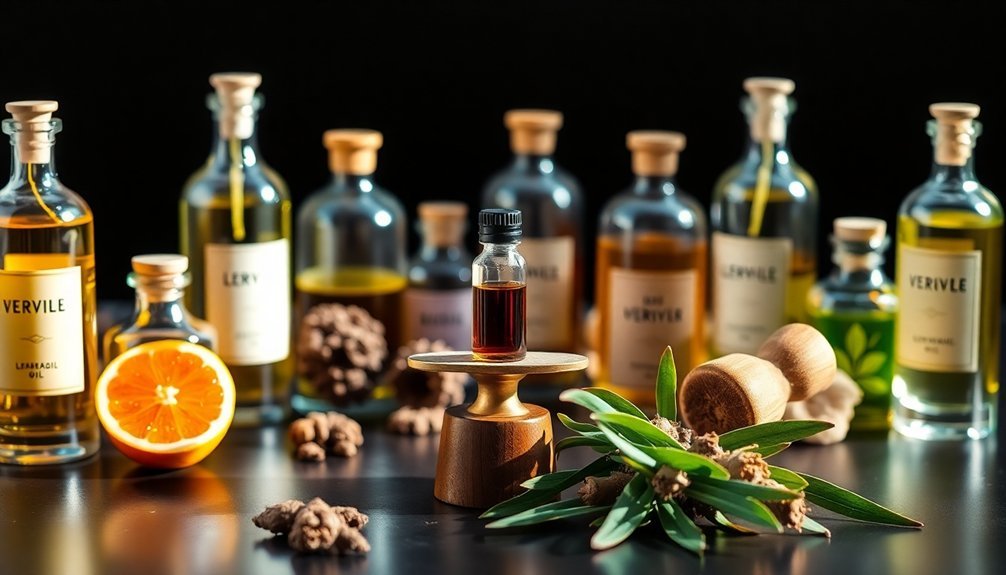
While vetiver serves as a powerful base note in natural perfumery, mastering its blend with other essential oils requires understanding the delicate balance of aromatic notes. You'll want to follow the 30/50/20 rule when creating your blends: 30% top notes, 50% middle notes, and 20% base notes.
| Oil Type | Examples | Blending Tips |
|---|---|---|
| Top Notes | Bergamot, Lemon | Add 3 drops per 10-drop blend |
| Middle Notes | Lavender, Rosemary | Use 5 drops per 10-drop blend |
| Base Notes | Sandalwood, Patchouli | Include 2 drops per 10-drop blend |
| Florals | Rose, Jasmine | Pairs well with vetiver's earthiness |
| Woody/Resinous | Cedarwood, Frankincense | Enhances vetiver's depth |
Try combining vetiver with compatible oils like rose absolute for a floral touch, or cedarwood for a woody dimension. You'll find that vetiver's deep, earthy aroma works particularly well with herbaceous and spicy notes.
Optimal Vetiver Concentration Levels
Three key factors determine preferable vetiver concentration in natural perfumes: cost, balance, and longevity. While vintage formulas like Guerlain's contained up to 30% vetiver oil, today's ideal concentration typically ranges between 10-20% due to rising production costs.
You'll find that modern perfumes achieve the best results by blending vetiver with complementary notes rather than using it as a dominant single note. For a balanced natural perfume, consider pairing vetiver with citrus, florals, or spicy elements. This approach enhances its versatility while maintaining the distinctive earthy character.
The preferable concentration should deliver 8-10 hours of wear time without overwhelming other notes. You can adjust the ratio based on your desired intensity, keeping in mind that vetiver's natural fixative properties help maintain consistent scent projection throughout the day.
Seasonal Vetiver Mixing Guidelines
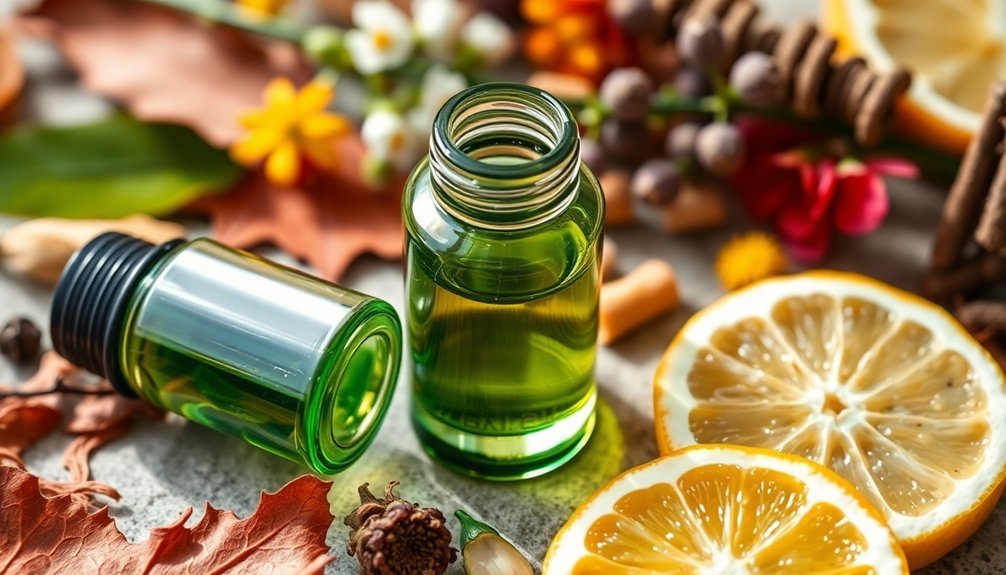
Successful vetiver blending requires careful seasonal adjustments to achieve the most appealing fragrances throughout the year.
Each season calls for distinct combinations to create the perfect ambiance and emotional response.
For ideal seasonal blending, follow these key ratios:
- Spring: Mix vetiver with 30% citrus notes, 20% florals, and balance with woody undertones for a fresh start.
- Summer: Create cooling blends using 40% citrus oils and 20% mint notes with vetiver as the base.
- Autumn: Combine 40% woody notes with vetiver, adding 20% spicy elements for warmth.
- Winter: Use 35% oriental notes with vetiver, incorporating 25% woody elements for depth.
You'll want to adjust these percentages slightly based on your specific oils and desired intensity, always keeping vetiver as your foundation note.
Vetiver Base Note Proportions
Essential vetiver ratios form the cornerstone of natural perfumery, with base notes typically comprising 15-30% of a complete fragrance blend. When working with vetiver, you'll want to balance its intense, earthy qualities with other notes to create a harmonious composition.
| Purpose | Vetiver Drops | Complementary Oils |
|---|---|---|
| Relaxing | 1-2 | Lavender, Palmarosa |
| Meditative | 2-3 | Bergamot, Geranium |
| Grounding | 3-4 | Cedarwood, Patchouli |
| Natural Perfume | 2-5 | Ylang Ylang, Peru Balsam |
You'll find vetiver's long-lasting properties make it ideal for creating memorable fragrances that can endure for over six hours. Start with smaller amounts and adjust according to your desired intensity, as vetiver's strong character can quickly dominate a blend if not properly balanced with complementary notes.
Testing and Adjusting Vetiver Strength
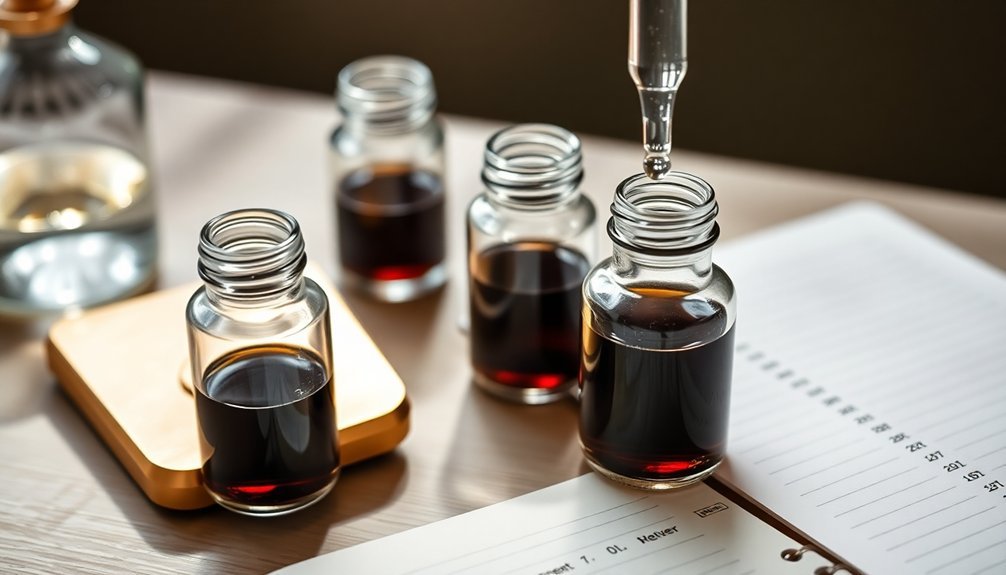
Once you've established your base vetiver proportions, mastering the art of testing and adjusting its strength will determine your blend's success. Start with a 10% concentration and prepare small test batches to evaluate the vetiver's impact on your composition.
For precise strength adjustments, follow these essential steps:
- Layer vetiver with complementary notes like bergamot or lavender to control its intensity.
- Add musks to soften or enhance the vetiver accord as needed.
- Allow each test blend to mature for proper evaluation.
- Compare multiple formulations side by side to identify ideal strength.
Remember that vetiver evolves over time, so continuous testing is vital.
You'll need to balance its fresh and deep notes while ensuring accompanying ingredients don't overshadow its character.
Consider seasonal factors and intended use when finalizing your vetiver strength.
Common Vetiver Mixing Mistakes
When you're working with vetiver in natural perfumes, one of the biggest mistakes you'll encounter is using too much in your base notes, which can overpower the entire composition and create an overwhelmingly earthy or smoky scent.
You'll also need to be careful with essential oil pairings, as vetiver doesn't play nicely with every ingredient and can clash particularly with certain citrus or floral notes if not properly balanced.
The key to success lies in understanding both the specific characteristics of your vetiver source (whether Haitian, Madagascan, or Indian) and how it interacts with your chosen complementary oils.
Overpowering the Base Notes
Creating a perfectly balanced vetiver fragrance requires careful attention to base note proportions, as even small formulation errors can lead to an overwhelming scent profile.
You'll need to carefully consider vetiver's concentration and its interaction with other base notes to achieve harmony. High concentrations of vetiver can dominate your fragrance, making it too earthy and overshadowing delicate notes.
To maintain balance, consider these critical factors:
- Keep vetiver concentration below traditional 30% levels
- Balance top, middle, and base notes evenly
- Choose complementary base notes like tobacco or sandalwood
- Monitor the evaporation curve of all ingredients
Pay attention to how vetiver interacts with other base notes like vanilla and ambergris. A well-structured fragrance allows each note to unfold naturally, with vetiver enhancing rather than overwhelming the overall composition.
Mismatched Essential Oil Pairings
Despite vetiver's versatility in natural perfumery, common mixing mistakes can derail even experienced perfumers' efforts to create balanced fragrances. You'll need to carefully consider aroma strengths, compatibility, and the interaction between top, middle, and base notes when creating your blends.
| Aspect | Common Mistake | Solution |
|---|---|---|
| Strength | Unbalanced ratios | Match oils with similar intensity |
| Testing | Insufficient trials | Conduct thorough compatibility tests |
| Notes | Improper layering | Balance top, middle, and base notes |
| Environment | Ignoring conditions | Test blends in various settings |
Remember that vetiver's unique properties require thorough testing with different carrier oils and environmental conditions. When working with various vetiver sources, you'll want to adjust your ratios accordingly, as quality and characteristics can vary greatly based on origin and seasonal factors.
Balancing Vetiver in Multi-Note Blends
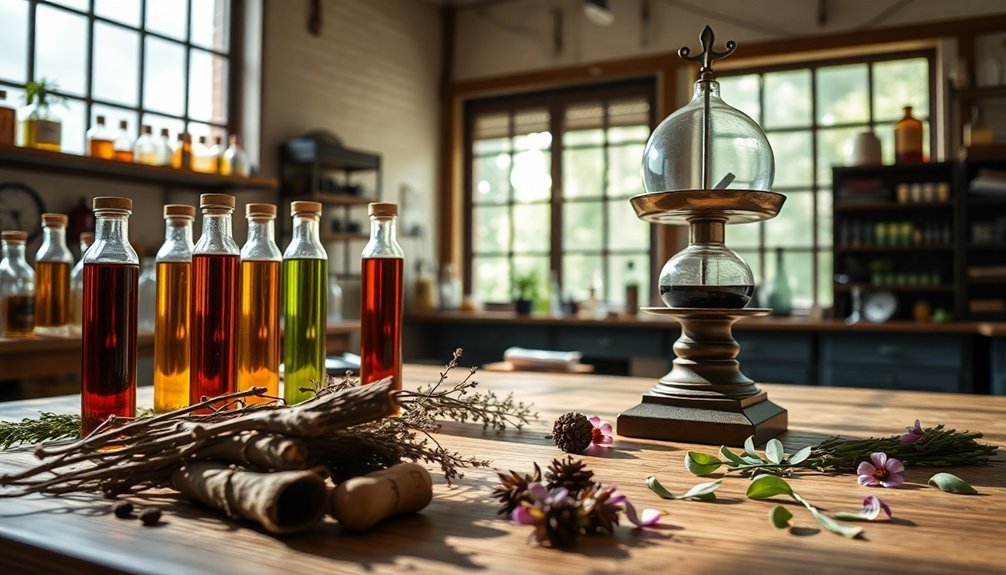
As one of perfumery's most versatile ingredients, vetiver shines in multi-note compositions where its earthy depth can anchor, contrast, or enhance other fragrance elements.
You'll find vetiver's adaptability particularly evident in four key blending categories:
- Woody blends with sandalwood and cedarwood for sophisticated, grounding effects
- Citrus combinations featuring bergamot and grapefruit for fresh, balanced scents
- Floral pairings with jasmine and rose that add complexity and depth
- Oriental mixtures incorporating spices like cardamom and pepper for exotic warmth
When you're working with vetiver, you can rely on its smoky undertones to complement both light and heavy notes.
You'll see this versatility in classic fragrances like Guerlain's Vetiver, where citrus brightens the earthy base, and Chanel's Sycomore, where woody notes enhance vetiver's natural depth.
Recommended Dilution Safety Standards
When working with Acetylated Vetiver Oil in natural perfumes, you'll need to follow strict concentration limits of 0.10% for leave-on products and 0.90% for hydroalcoholic fragrances to guarantee safety.
You should always conduct a patch test on a small area of skin before using your blends, mixing the oil with 1% alpha-tocopherol for enhanced safety.
For peak safety and compliance, mix your vetiver with appropriate carrier oils at the recommended ratios, keeping detailed records of your dilutions to maintain consistency with IFRA standards.
Safe Concentration Guidelines
Understanding safe concentration guidelines is essential for crafting natural perfumes with vetiver.
You'll need to follow specific limits based on your product type and intended use to guarantee safety and compliance with industry standards.
For your natural perfume formulations, follow these key concentration limits:
- 0.07% vetiveryl acetate for lip-based products
- 0.35% vetiveryl acetate for products applied to shaved skin
- 1.04% vetiveryl acetate for unshaved skin applications
- 0.55% vetiveryl acetate for facial and hand creams
When working with acetylated vetiver oil, you'll find that IFRA standards allow higher concentrations for certain categories.
While vintage perfumes like Guerlain's Vetiver contained up to 30% vetiver, modern formulations typically use lower concentrations to achieve better balance with other fragrance notes.
Patch Testing Best Practices
Following the established concentration guidelines, you'll need to verify your vetiver formulation's safety through proper patch testing.
Conduct your testing in a quiet, distraction-free environment to minimize errors. Before starting, label all your test patches clearly and organize them systematically.
You'll want to prepare your fragrance mixes just before application, as volatile components can evaporate and affect results.
Always wear gloves when handling the allergens and use clean application tools. If initial patch tests yield negative results but you still suspect sensitivity, consider testing with supplemental allergens or your specific vetiver blend.
When interpreting results, remember that a positive patch test only indicates potential allergic contact dermatitis if there's relevant exposure to the allergen in your formulation.
Carrier Oil Mixing Ratios
Safe and effective vetiver perfumes begin with proper carrier oil ratios, which serve as the foundation for your aromatic creations.
When mixing your vetiver perfume, you'll want to follow standard dilution guidelines to guarantee both safety and ideal fragrance performance.
For a 1-ounce (30ml) bottle of perfume, follow these essential ratios:
- Start with 5-6 drops for a gentle 1% dilution if you're pregnant, nursing, or have sensitive skin.
- Use 10-12 drops for a standard 2% dilution suitable for daily wear.
- Increase to 15-30 drops for a stronger perfume concentration.
- Don't exceed 60 drops (10% dilution) even for intense fragrances.
Choose high-quality organic carrier oils like jojoba or fractionated coconut oil, as they'll provide the best stability and skin compatibility for your vetiver blend.
Longevity and Fixation Factors

When crafting natural perfumes with vetiver, its exceptional longevity and fixative properties make it a cornerstone ingredient for lasting fragrances.
You'll find that higher concentrations of vetiver, particularly from quality sources like Haiti or Bourbon, provide superior fixation and staying power.
To maximize longevity, you'll want to pair vetiver with complementary fixatives like oakmoss and patchouli.
The percentage of vetiver in your formula directly impacts its fixative strength – higher amounts typically yield better results.
However, you'll need to balance this with your desired aromatic profile, as vetiver's smoky, earthy qualities will become more pronounced with increased concentration.
When you combine vetiver with woody notes like cedar or sandalwood, you'll enhance the overall longevity while maintaining a harmonious blend.
Temperature Impact on Vetiver Ratios
Temperature plays an essential role in determining the ideal vetiver ratios for your natural perfume formulations.
You'll need to adjust your vetiver proportions based on the ambient temperature where you're creating and storing your blends.
When working with vetiver, consider these temperature-based ratio adjustments:
- Use 5-8% vetiver in cool conditions to preserve the fresh, green notes while maintaining good fixation.
- Increase to 10-12% in warmer temperatures to compensate for faster evaporation rates.
- Lower to 3-5% when blending with citrus oils in cool environments to prevent overwhelming the bright top notes.
- Keep at 8-10% for woody accords in moderate temperatures to achieve ideal balance.
Remember that proper temperature control during storage will help maintain your chosen ratios' effectiveness and preserve the perfume's intended character.
Storage and Maturation Guidelines
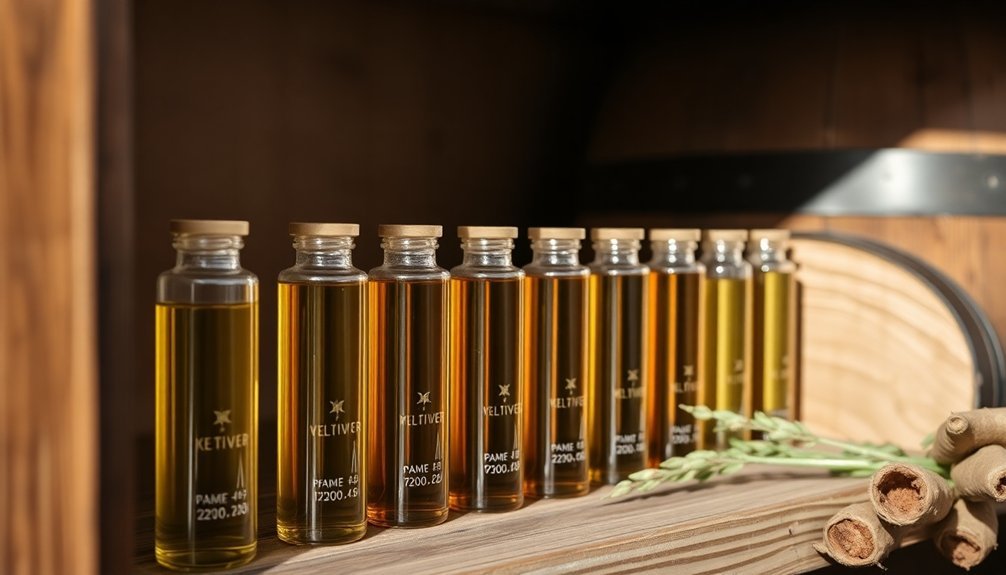
Proper storage and maturation practices serve as the foundation for creating exceptional natural perfumes with vetiver. You'll need to store your blend in a dark glass container away from sunlight and humidity while maintaining cool temperatures to preserve its integrity.
For vetiver-based perfumes, maturation is essential as it transforms the initial earthy notes into deeper, sweeter aromas. While 48 hours is the minimum maturation period, you can expect the best results after 4-6 weeks.
| Maturation Stage | Expected Results |
|---|---|
| 48 Hours | Initial note blending |
| 1-2 Weeks | Developing harmony |
| 3-4 Weeks | Enhanced depth |
| 6+ Weeks | Full aroma profile |
During maturation, you'll notice vetiver's complex profile of leathery, smoky, and sweet undertones becoming more cohesive, ultimately improving its fixative properties and longevity.
Frequently Asked Questions
Can Vetiver Essential Oil Trigger Allergic Reactions in Sensitive Skin?
Yes, you can experience allergic reactions to vetiver essential oil if you have sensitive skin. It's important to do a patch test first, as reactions can include redness, itching, and rashes.
Does the Age of Vetiver Roots Affect the Final Perfume Quality?
Yes, the age of vetiver roots considerably affects your perfume's quality. You'll find older roots produce smoother, more complex oils with enhanced woody notes, while younger roots give you stronger, smokier characteristics in the final fragrance.
How Does Altitude Affect Vetiver's Potency When Sourcing for Perfumes?
You'll find higher-altitude vetiver typically yields more potent essential oils with sweeter notes, while lower-altitude varieties produce earthier aromas. The altitude's impact on root depth directly influences the oil's strength and complexity.
Which Extraction Method Produces the Most Sustainable Vetiver Oil?
You'll get the most sustainable vetiver oil through Supercritical CO2 Extraction. It's energy-efficient, leaves no toxic residues, and maximizes the yield of key components while preserving the root's natural qualities.
Do Different Soil Types Influence Vetiver's Aromatic Profile in Perfumery?
Yes, you'll find that soil type greatly impacts vetiver's aroma. Clay soils produce deeper, earthier notes, while sandy soils create lighter, fresher scents. Rich organic matter yields more complex, nuanced profiles.
In Summary
You'll find perfect vetiver ratios vary based on your unique formulation goals, but generally aim for 1-3% in natural perfumes. Remember to adjust the concentration depending on season, temperature, and other essential oils in your blend. Always start with lower ratios and gradually increase while following safety guidelines. Store your vetiver blends properly, and you'll achieve the ideal balance of this rich, earthy note.





Leave a Reply